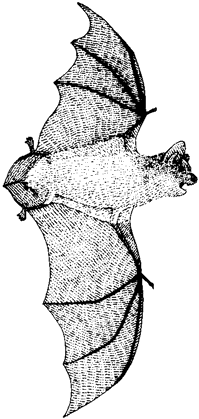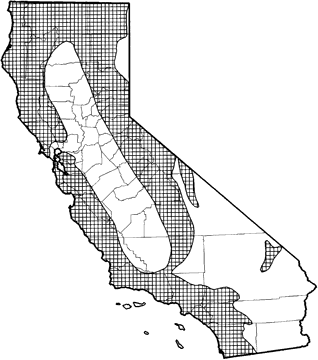
Long-legged Myotis
Distribution, Abundance, and Seasonality
The long-legged myotis is common in California, occurring in the coastal ranges from Oregon to Mexico, the Cascade/Sierra Nevada ranges to southern California, most of the Great Basin region, and in several Mojave Desert mountain ranges. It is absent only from the Central Valley, the Colorado and Mojave deserts (except in mountain ranges), and from eastern Lassen and Modoc cos. This species is most common in woodland and forest habitats above 1200 m (4000 ft). Also forages in chaparral, coastal scrub, Great Basin shrub habitats, and in early successional stages of woodlands and forests. Uncommon in desert and arid grassland habitats. Records range from sea level to 3600 m (11,400 ft); the latter record is from New Mexico (Findley et al. 1975).

Range Map
Specific Habitat Requirements
Feeding: The long-legged myotis feeds on flying insects, primarily moths (Black 1974, Whitaker et al. 1977, 1981). Flight of this species is strong and direct. It feeds at fairly low heights 3-5 m (10-15 ft) over water, close to trees and cliffs, and in openings in woodlands and forests. This species is not particularly maneuverable, and generally it makes a single attempt at capture during a feeding pass. Associated with these flight and feeding patterns is the ability to detect prey at a long distance (10 m) (Fenton and Bell 1979). The long-legged myotis responds to short-lived patches of high insect density, often congregating with other bat species (Bell 1980).
Cover: The long-legged myotis roosts in rock crevices, buildings, under tree bark, in snags, mines, and caves. Separate day and night roosts may be used. Trees probably are the most important day roosts. Caves and mines are used only as night roosts. There are a few records of hibernation in caves.
Reproduction: This species forms nursery colonies numbering hundreds of individuals, usually under bark or in hollow trees, but occasionally in crevices or buildings.
Water: This species drinks regularly, and has poor urine-concentrating ability.
Pattern: Feeds over water, and over open habitats, using denser woodlands and forests for cover and reproduction (Warner and Czaplewski 1984).
Species Life History
Activity Patterns: Nocturnal. Hibernates. Emerges at or shortly after, dusk, later than some other species (e.g., Myotis californicus, M. occultus, and Pipistrellus hesperus) (Jones 1965). This fairly cold-tolerant species hibernates during winter.
Seasonal Movements / Migration: Probably makes short migrations to suitable hibernacula. The winter range is poorly known.
Home Range: No data found.
Territory: Often found in large colonies.
Reproduction: Mating occurs in the fall, and the young are born in June and July. Lactating females are found in July and August. The young may begin flying in mid-July. Year-old bats are capable of reproduction (Schowalter 1980). The maximum recorded longevity is 21 yr (Tuttle and Stevenson 1982).
Niche: The long-legged myotis is a small, direct-flying aerial insectivore, which seems to feed primarily on moths.
Sources & References
California Department of Fish and Game, 1999.
California's Wildlife, Sacramento, CA.
Written by: J. Harris, reviewed by: P. Brown, edited by: D. Alley, R. Duke
Barbour, R. W., and W. H. Davis. 1969. Bats of America. Univ. of Kentucky Press, Lexington. 286pp. Bell, G. P. 1980. Habitat use and response to patches of prey by desert insectivorous bats. Can. J. Zool. 58:1876-1883. Black, H. L. 1974. A north temperate bat community: structure and prey populations. J. Mammal. 55:138-157. Burt, W. H. 1934. The mammals of southern Nevada. Trans. San Diego Soc. Nat. Hist. 7:375-427. Dalquest, W. W. and M. C. Ramage. 1946. Notes on the long-legged bat (Myotis volans) at Old Fort Tejon and vicinity, California. J. Mammal. 27:60-63. Davis, W. B. 1960. The mammals of Texas. Texas Game and Fish Comm., Austin. 252pp. Davis, W. H., and R. W. Barbour. 1970. Life history data on some southwestern Myotis. Southwest. Nat. 15:261-263. Deacon, J. E., W. G. Bradley, and K. M. Larsen. 1964. Ecological distribution of the mammals of Clark Canyon, Charleston Mountains, Nevada. J. Mammal. 45:397-409. Fenton, M. B., and G. P. Bell 1979. Echolocation and feeding behavior in four species of Myotis (Chiroptera). Can. J. Zool. 57:1271-1277. Findley, J. S., A. H. Harris, D. E. Wilson, and C. Jones. 1975. Mammals of New Mexico. Univ. New Mexico Press. Albuquerque. 360pp. Geluso, K. N. 1978. Urine concentrating ability and renal structure of insectivorous bats. J. Mammal. 59:312-323. Jones, C. 1965. Ecological distribution and activity records of bats of the Mogollon Mountains area of New Mexico and adjacent Arizona. Tulane Studies Zool. 12:93-100. Schowalter, D. B. 1980. Swarming, reproduction, and early hibernation of Myotis lucifugus and M. volans in Alberta, Canada. J. Mammal. 61:350-354. Sumner, L., and J. S. Dixon. 1953. Birds and mammals of the Sierra Nevada. Univ. California Press, Berkeley. 484pp. Tuttle, M. D., and D. Stevenson. 1982. Growth and survival of bats. Pages 105-150 in T. H. Kunz, ed. Ecology of bats. Plenum Publ. Co., New York. 425pp. Vaughan, T. A. 1954. Mammals of the San Gabriel Mountains of California. Univ. Kans., Mus. Nat. Hist. Publ. 7:513-582. Warner, R. M., and N. J. Czaplewski. 1984. Myotis volans. Mammal. Species No. 224. 4pp. Whitaker, J. O., Jr., C. Maser, and L. E. Keller. 1977. Food habits of bats of western Oregon. Northwest Sci. 51:46-55. Whitaker, J. O., Jr., C. Maser, and S. P. Cross. 1981. Food habits of eastern Oregon bats, based on stomach and scat analyses. Northwest Sci. 55:281-292.
California Animal Facts | California's Wildlife